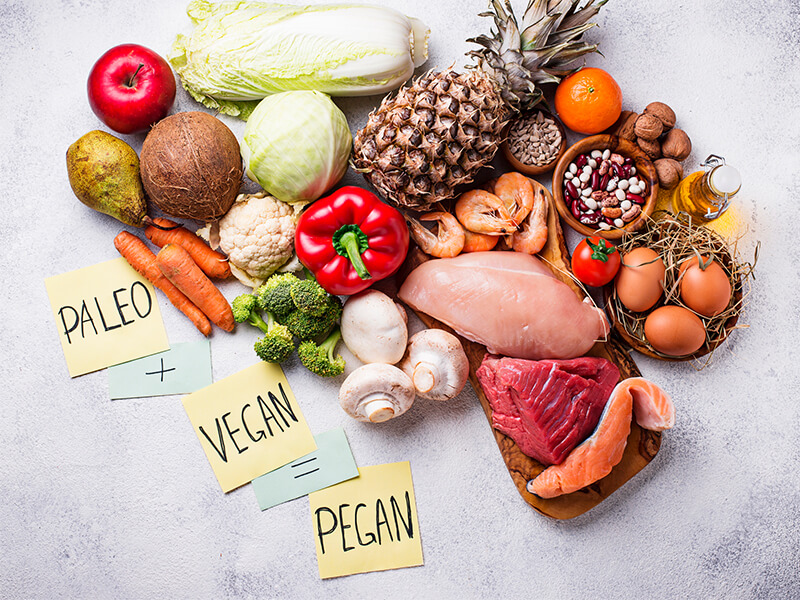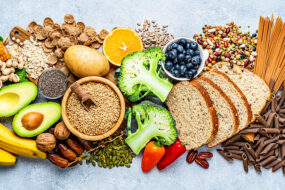The pros and cons of the pegan diet
A blend of paleo and vegan-style eating, the pegan diet promises the best of both worlds. But do our experts give it the tick?
The paleo diet and veganism are two increasingly popular approaches to eating, and now comes the pegan diet – a hybrid of the two created by Dr Mark Hyman who believes whole, fresh food can help maintain good health.
Less restrictive than either a vegan or paleo diet, the pegan diet doesn’t eliminate proteins such as meat and eggs as with veganism, or avoid all grains as on a paleo diet.
Instead, Dr Hyman encourages focus on glycemic load, eating the right fats, eating mostly plants, nuts and seeds, having some sustainably raised meats, and generally avoiding dairy, gluten, sugar and beans.
“The best strategy for a long and healthy life is to eat your medicine – get your drugs at the farmacy, not the pharmacy,” he writes in The Pegan Diet.
“Food is far more than just calories or energy to fuel our bodies.
“It is information, instructions that regulate every function of our bodies in real time… every time you take a bite of food, consider that you are programming your biology for health or disease.”
- Plant v meat: Are vegans healthier than carnivores?
What can you eat on a pegan diet?
Promoting nutrient-dense foods, about 75 per cent of the pegan diet contains vegetables and fruit, while the remaining 25 per cent comprises protein, eggs, and healthy fats such as nuts and seeds.
“The pegan diet encourages us to eat lots of plant-based foods like vegetables, salad foods, nuts, seeds and legumes. It also includes fruit,” says dietitian Margaret Hays.
House of Wellness TV co-host, nutrition coach and personal trainer Luke Hines says the abundance of fruits and vegetables “gives us a spectrum of fibre that feeds our gut bacteria”.
“Our gut is often referred to as our second brain and it has an effect on our energy, mood, focus, hormones and how we sleep,” he says.
Eggs, oily fish and grass-fed meat should be eaten in small amounts along with healthy fats.
These can include grass-fed butter, ghee, tallow, duck fat and coconut oil, says Luke.
Kefir and grass-fed full fat unsweetened yoghurt can also be eaten.
If you eat dairy, Dr Hyman recommends sheep or goat-based products as they have lower levels of the A1 casein protein that contributes to inflammation.
- Happy belly: 5 natural ways to boost gut health
Foods to limit or avoid on the pegan diet
Dr Hyman pinpoints “bad fats, refined sugars, excessive starches, processed foods, conventional dairy products and poor-quality food” as being key culprits in damaging our body.
Foods containing highly processed sugars like high-fructose corn syrup, refined white sugar and brown sugar and artificial sugars are off-limits.
But you can have limited amounts of honey, coconut sugar, date sugar, maple syrup and fresh fruit juice.
Processed and refined grains are also off the list, but the diet recommends eating 60g to 100g of whole grains per day.
- Inflammatory foods: What to eat and avoid to keep inflammation at bay
Experts’ verdict on the pegan diet
Margaret: “This diet focuses on eating whole foods, fruits and vegies and cutting out processed foods and sugar – which is positive.
“It’s a good idea to limit meat to two or three serves a week, but it cuts out grains, legumes and dairy.
“Dairy is important for calcium and grains are a source of energy for our brain and muscles and they provide fibre and vitamins.
“It’s another diet with an unusual name – I wouldn’t recommend it.”
Luke: “I’m a big fan of this diet. It is based on real food and we can get all the nutrients we need from simple, real food.
“We all need to eat more vegetables and being mindful about how much animal protein and healthy fat we eat is a boost for our health.
“You won’t have to count calories and will become an intuitive eater – your body will be more receptive to how you feel, so you’ll know when you are full or when you need more energy.
“It’s a good way to live.”
- Nutrient rich: Easy and delicious ways to boost your fruit and vegie intake
Written by Sarah Marinos.





